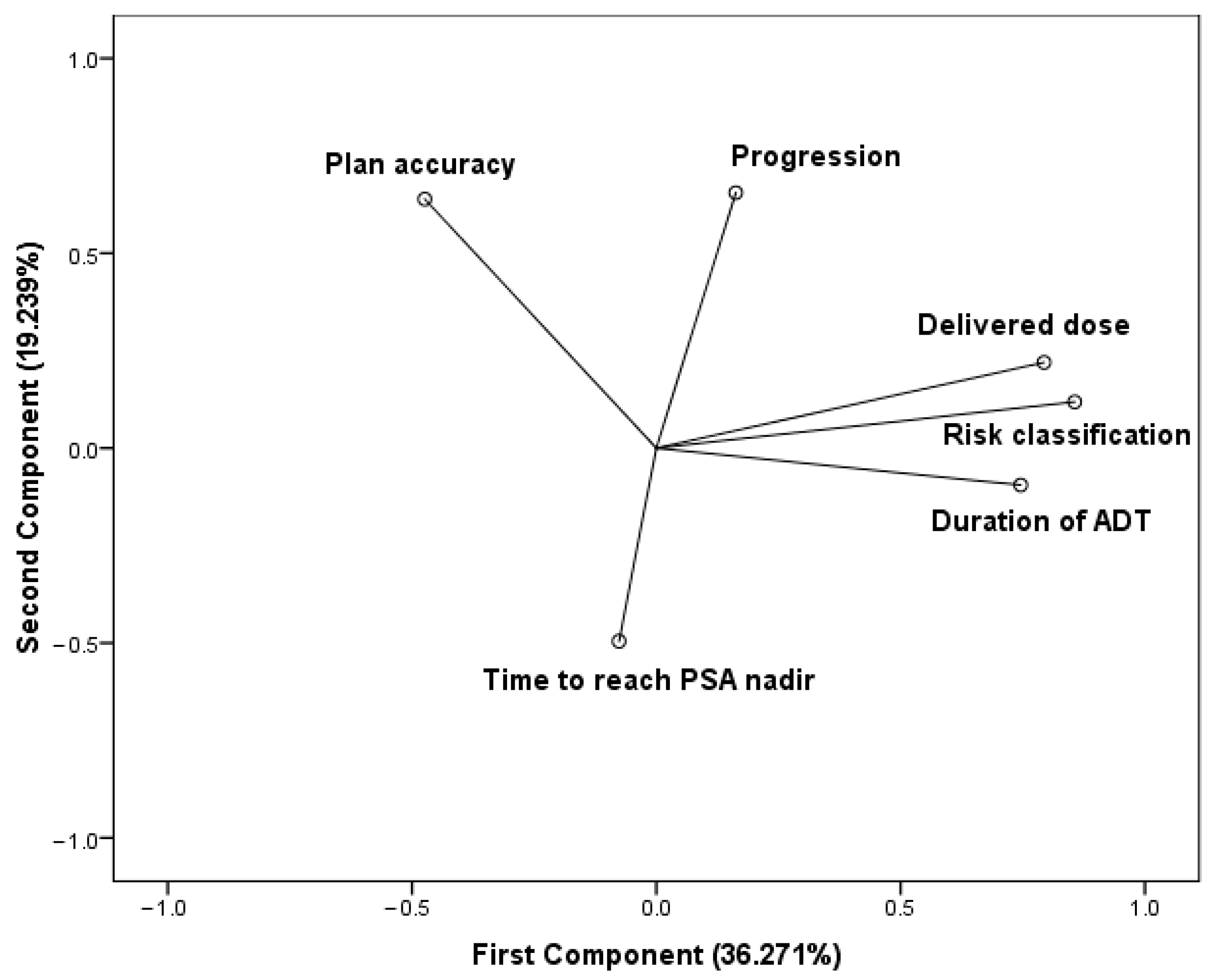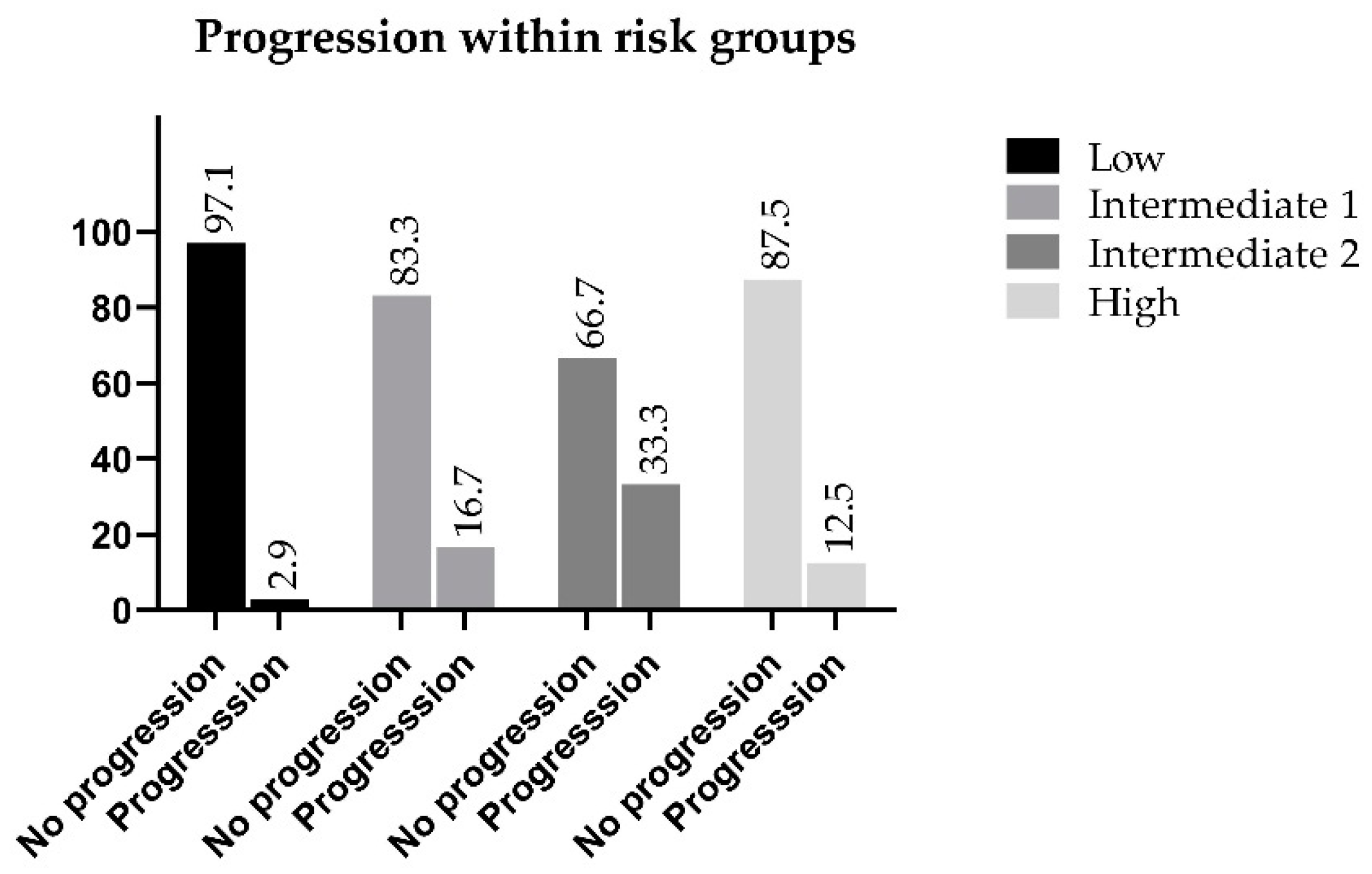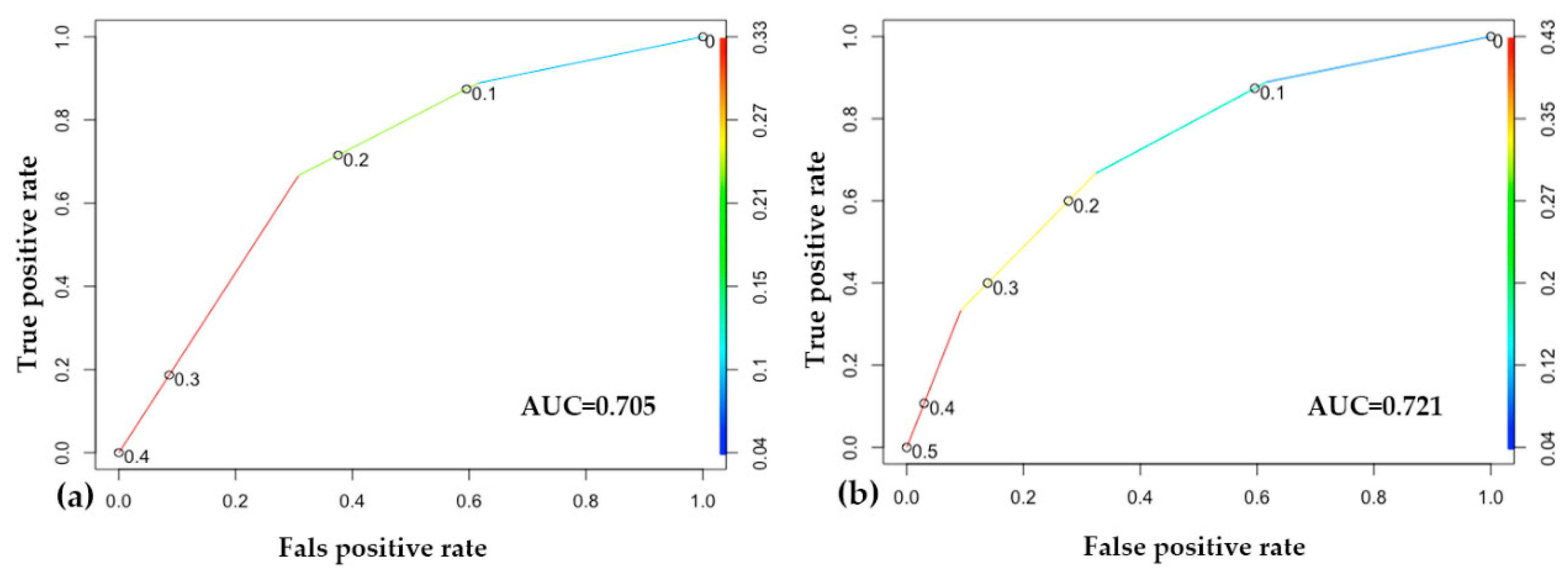Should We Reconsider the Necessity of a Refinement of Prostate Cancer Risk Classification and Radiotherapy Treatment Strategy? Experiences from a Retrospective Analysis of Data from a Single Institution
Abstract
1. Introduction
2. Materials and Methods
2.1. Enrolled Patients
2.2. Determination of Treatments
2.3. Definition of Progression
2.4. Explanatory Variables
2.5. Reclassification
2.6. Machine Learning Models: Logistic Regression for Prediction
2.7. Statistical Analysis
3. Results
3.1. Intermediate-Risk Population Showed the Highest Percentage of Progression among the Categories
3.2. Relationship of the Variables
3.3. Risk Classification Is the Most Associated with Progression among the Investigated Variables
Backward Stepwise Logistic Model
3.4. Intermediate-Risk Group Tends to Form Two Subgroups When Risk Classification Is Reconsidered According to the International Society of Urological Pathology (ISUP) Recommendations
3.5. The Progression-Free Survival Probability of the Intermediate Risk Patients (ISUP Grade 2 and 3) Is Worse than the High Risk Group
3.6. Data Validation by Machine Learning Approach
4. Discussion
5. Conclusions
Supplementary Materials
Author Contributions
Funding
Institutional Review Board Statement
Informed Consent Statement
Data Availability Statement
Conflicts of Interest
References
- Mottet, N.; Bellmunt, J.; Bolla, M.; Briers, E.; Cumberbatch, M.G.; De Santis, M.; Fossati, N.; Gross, T.; Henry, A.M.; Joniau, S.; et al. EAU-ESTRO-SIOG Guidelines on Prostate Cancer. Part 1: Screening, Diagnosis, and Local Treatment with Curative Intent. Eur. Urol. 2017, 71, 618–629. [Google Scholar] [CrossRef] [PubMed]
- Sharifi, N.; Gulley, J.L.; Dahut, W.L. Androgen deprivation therapy for prostate cancer. JAMA 2005, 294, 238–244. [Google Scholar] [CrossRef] [PubMed]
- Widmark, A.; Klepp, O.; Solberg, A.; Damber, J.-E.; Angelsen, A.; Fransson, P.; Lund, J.-Å.; Tasdemir, I.; Hoyer, M.; Wiklund, F.; et al. Endocrine treatment, with or without radiotherapy, in locally advanced prostate cancer (SPCG-7/SFUO-3): An open randomised phase III trial. Lancet 2009, 373, 301–308. [Google Scholar] [CrossRef]
- Schmidt, B.; Eapen, R.S.; Cowan, J.E.; Broering, J.M.; Greene, K.L.; Carroll, P.R.; Cooperberg, M.R. Practice patterns of primary EBRT with and without ADT in prostate cancer treatment. Prostate Cancer Prost. Dis. 2019, 22, 117–124. [Google Scholar] [CrossRef]
- Amit, U.; Lawrence, Y.R.; Weiss, I.; Symon, Z. Radiotherapy with or without androgen deprivation therapy in intermediate risk prostate cancer? Radiat. Oncol. 2019, 14, 99. [Google Scholar] [CrossRef]
- Rudat, V.; Nour, A.; Hammoud, M.; Alaradi, A.; Mohammed, A. Image-guided intensity-modulated radiotherapy of prostate cancer: Analysis of interfractional errors and acute toxicity. Strahlenther. Onkol. 2016, 192, 109–117. [Google Scholar] [CrossRef][Green Version]
- Treece, S.J.; Mukesh, M.; Rimmer, Y.L.; Tudor, S.J.; Dean, J.C.; Benson, R.J.; Gregory, D.L.; Horan, G.; Jefferies, S.J.; Russell, S.G.; et al. The value of image-guided intensity-modulated radiotherapy in challenging clinical settings. Br. J. Radiol. 2013, 86, 20120278. [Google Scholar] [CrossRef]
- Cornford, P.; Bellmunt, J.; Bolla, M.; Briers, E.; De Santis, M.; Gross, T.; Henry, A.M.; Joniau, S.; Lam, T.B.; Mason, M.D.; et al. EAU-ESTRO-SIOG Guidelines on Prostate Cancer. Part II: Treatment of Relapsing, Metastatic, and Castration-Resistant Prostate Cancer. Eur. Urol. 2017, 71, 630–642. [Google Scholar] [CrossRef]
- European Society for Radiotherapy and Oncology (ESTRO) Guideline. Available online: https://www.estro.org/Science/Guidelines (accessed on 20 May 2020).
- Marks, L.B.; Yorke, E.D.; Jackson, A.; Ten Haken, R.K.; Constine, L.S.; Eisbruch, A.; Bentzen, S.M.; Nam, J.; Deasy, J.O. Use of normal tissue complication probability models in the clinic. Int. J. Radiat. Oncol. Biol. Phys. 2010, 76, S10–S19. [Google Scholar] [CrossRef]
- International Commission on Radiation Units and Measurements. Journal of the ICRU; Oxford University Press: Oxford, UK; Available online: http://oxfordsfx-direct.hosted.exlibrisgroup.com/oxford?url%5Fver=Z39.88-2004&ctx%5Fver=Z39.88-2004&ctx%5Fenc=info:ofi/enc:UTF-8&rfr%5Fid=info:sid/sfxit.com:opac%5F856&url%5Fctx%5Ffmt=info:ofi/fmt:kev:mtx:ctx&sfx.ignore%5Fdate%5Fthreshold=1&rft.object%5Fid=111016560264784&svc%5Fval%5Ffmt=info:ofi/fmt:kev:mtx:sch%5Fsvc& (accessed on 20 May 2020).
- Epstein, J.I.; Egevad, L.; Amin, M.B.; Delahunt, B.; Srigley, J.R.; Humphrey, P.A.; Committee, G. The 2014 International Society of Urological Pathology (ISUP) Consensus Conference on Gleason Grading of Prostatic Carcinoma: Definition of Grading Patterns and Proposal for a New Grading System. Am. J. Surg. Pathol. 2016, 40, 244–252. [Google Scholar] [CrossRef]
- Turkbey, B.; Mani, H.; Shah, V.; Rastinehad, A.R.; Bernardo, M.; Pohida, T.; Pang, Y.; Daar, D.; Benjamin, C.; McKinney, Y.L.; et al. Multiparametric 3T prostate magnetic resonance imaging to detect cancer: Histopathological correlation using prostatectomy specimens processed in customized magnetic resonance imaging based molds. J. Urol. 2011, 186, 1818–1824. [Google Scholar] [CrossRef] [PubMed]
- Quan, E.M.; Li, X.; Li, Y.; Wang, X.; Kudchadker, R.J.; Johnson, J.L.; Kuban, D.A.; Lee, A.K.; Zhang, X. A comprehensive comparison of IMRT and VMAT plan quality for prostate cancer treatment. Int. J. Radiat. Oncol. Biol. Phys. 2012, 83, 1169–1178. [Google Scholar] [CrossRef] [PubMed]
- Lu-Yao, G.L.; Albertsen, P.C.; Moore, D.F.; Shih, W.; Lin, Y.; DiPaola, R.S.; Yao, S.L. Survival following primary androgen deprivation therapy among men with localized prostate cancer. JAMA 2008, 300, 173–181. [Google Scholar] [CrossRef] [PubMed]
- Jones, C.U.; Hunt, D.; McGowan, D.G.; Amin, M.B.; Chetner, M.P.; Bruner, D.W.; Leibenhaut, M.H.; Husain, S.M.; Rotman, M.; Souhami, L.; et al. Radiotherapy and Short-Term Androgen Deprivation for Localized Prostate Cancer. N. Engl. J. Med. 2011, 365, 107–118. [Google Scholar] [CrossRef] [PubMed]
- Mottet, N.; van den Bergh, R.C.N.; Briers, E. EAU Guidelines edn. Presented at the EAU Annual Congress Barcelona. 2019. Available online: https://uroweb.org/guidelines/ (accessed on 20 May 2020).
- Roach, M.; Bae, K.; Speight, J.; Wolkov, H.B.; Rubin, P.; Lee, R.J.; Lawton, C.; Valicenti, R.; Grignon, D.; Pilepich, M.V. Short-term neoadjuvant androgen deprivation therapy and external-beam radiotherapy for locally advanced prostate cancer: Long-term results of RTOG 8610. J. Clin. Oncol. 2008, 26, 585–591. [Google Scholar] [CrossRef] [PubMed]
- Denham, J.W.; Steigler, A.; Lamb, D.S.; Joseph, D.; Turner, S.; Matthews, J.; Atkinson, C.; North, J.; Christie, D.; Spry, N.A.; et al. Short-term neoadjuvant androgen deprivation and radiotherapy for locally advanced prostate cancer: 10-year data from the TROG 96.01 randomised trial. Lancet Oncol. 2011, 12, 451–459. [Google Scholar] [CrossRef]
- D’Amico, A.V.; Schultz, D.; Loffredo, M.; Dugal, R.; Hurwitz, M.; Kaplan, I.; Beard, C.J.; Renshaw, A.A.; Kantoff, P.W. Biochemical Outcome Following External Beam Radiation Therapy with or Without Androgen Suppression Therapy for Clinically Localized Prostate Cancer. JAMA 2000, 284, 1280–1283. [Google Scholar] [CrossRef]
- Bolla, M.; Van Tienhoven, G.; Warde, P.; Dubois, J.B.; Mirimanoff, R.-O.; Storme, G.; Bernier, J.; Kuten, A.; Sternberg, C.; Billiet, I.; et al. External irradiation with or without long-term androgen suppression for prostate cancer with high metastatic risk: 10-year results of an EORTC randomised study. Lancet Oncol. 2010, 11, 1066–1073. [Google Scholar] [CrossRef]
- Bolla, M.; de Reijke, T.M.; Van Tienhoven, G.; Van den Bergh, A.C.M.; Oddens, J.; Poortmans, P.M.P.; Gez, E.; Kil, P.; Akdas, A.; Soete, G.; et al. Duration of Androgen Suppression in the Treatment of Prostate Cancer. N. Engl. J. Med. 2009, 360, 2516–2527. [Google Scholar] [CrossRef]
- Philip, J.S.; Matthew, R.S. Adverse Effects of Androgen Deprivation Therapy: Defining the Problem and Promoting Health among Men with Prostate Cancer. J. Natl. Compr. Cancer Netw. 2010, 8, 211–223. [Google Scholar] [CrossRef]
- Briganti, A.; Larcher, A.; Abdollah, F.; Capitanio, U.; Gallina, A.; Suardi, N.; Bianchi, M.; Sun, M.; Freschi, M.; Salonia, A.; et al. Updated nomogram predicting lymph node invasion in patients with prostate cancer undergoing extended pelvic lymph node dissection: The essential importance of percentage of positive cores. Eur. Urol. 2012, 61, 480–487. [Google Scholar] [CrossRef] [PubMed]
- Studer, U.E.; Collette, L.; Whelan, P.; Albrecht, W.; Casselman, J.; de Reijke, T.; Knönagel, H.; Loidl, W.; Isorna, S.; Sundaram, S.K.; et al. Using PSA to guide timing of androgen deprivation in patients with T0-4 N0-2 M0 prostate cancer not suitable for local curative treatment (EORTC 30891). Eur. Urol. 2008, 53, 941–949. [Google Scholar] [CrossRef] [PubMed]
- Spence, W. Personalising Prostate Radiotherapy in the Era of Precision Medicine: A Review. J. Med. Imaging Radiat. Sci. 2018, 49, 376–382. [Google Scholar] [CrossRef] [PubMed]





| Risk | |||||
|---|---|---|---|---|---|
| Low | Intermediate | High | Total Cases | ||
| No progression | Number of cases | 33 | 25 | 29 | 87 |
| % Within progression | 37.90% | 28.70% | 33.30% | 100% | |
| % Within risk | 97.10% | 78.10% | 87.90% | 87.90% | |
| % Of total | 33.30% | 25.30% | 29.30% | 87.90% | |
| Progression | Number of cases | 1 | 7 | 4 | 12 |
| % Within progression | 8.30% | 58.30% | 33.30% | 100.00% | |
| % Within risk | 2.90% | 21.90% | 12.10% | 12.10% | |
| % Of total | 1.00% | 7.10% | 4.00% | 12.10% | |
| Total cases | Number of cases | 34 | 32 | 33 | 99 |
| % Within progression | 34.30% | 32.30% | 33.30% | 100.00% | |
| % Within risk | 100.00% | 100.00% | 100.00% | 100.00% | |
| % Of total | 34.30% | 32.30% | 33.30% | 100.00% | |
| Coefficient (B) | S.E. | Sig. | ||
|---|---|---|---|---|
| Step 1 | Delivered dose | 0.079 | 0.208 | 0.706 |
| Plan accuracy | 0.289 | 0.304 | 0.343 | |
| Risk 1 | −0.910 | 1.495 | 0.543 | |
| Risk 2 | 1.138 | 0.892 | 0.202 | |
| Risk 3 | 0.098 | |||
| ADT duration (months) | 0.009 | 0.018 | 0.622 | |
| Time to reach PSA nadir (months) | 0.000 | 0.044 | 0.995 | |
| Constant | −37.204 | 35.104 | 0.289 | |
| Step 2 | Delivered dose | 0.079 | 0.208 | 0.706 |
| Plan accuracy | 0.289 | 0.304 | 0.343 | |
| Risk 1 | −0.910 | 1.494 | 0.543 | |
| Risk 2 | 1.138 | 0.891 | 0.201 | |
| Risk 3 | 0.097 | |||
| ADT duration (months) | 0.009 | 0.018 | 0.620 | |
| Constant | −37.194 | 35.073 | 0.289 | |
| Step 3 | Plan accuracy | 0.285 | 0.300 | 0.343 |
| Risk 1 | −1.223 | 1.246 | 0.326 | |
| Risk 2 | 0.992 | 0.792 | 0.210 | |
| Risk 3 | 0.090 | |||
| ADT duration (months) | 0.010 | 0.018 | 0.579 | |
| Constant | −30.585 | 29.738 | 0.304 | |
| Step 4 | Plan accuracy | 0.233 | 0.283 | 0.410 |
| Risk 1 | −1.409 | 1.200 | 0.240 | |
| Risk 2 | 0.871 | 0.756 | 0.249 | |
| Risk 3 | 0.091 | |||
| Constant | −25.113 | 27.799 | 0.366 | |
| Step 5 | Risk 1 | −1.228 | 1.182 | 0.299 |
| Risk 2 | 0.996 | 0.742 | 0.180 | |
| Risk 3 * | 0.086 | |||
| Constant | −2.269 | 0.606 | 0.000 |
| Risk | ||||||
|---|---|---|---|---|---|---|
| Low | Intermediate 1 | Intermediate 2 | High | Total Cases | ||
| No progression | Number of cases | 33 | 20 | 6 | 28 | 87 |
| % Within progression | 37.9% | 23.0% | 6.9% | 32.2% | 100.0% | |
| % Within risk | 97.1% | 83.3% | 66.7% | 87.5% | 87.9% | |
| % Of total | 33.3% | 20.2% | 6.1% | 28.3% | 87.9% | |
| Progression | Number of cases | 1 | 4 | 3 | 4 | 12 |
| % Within progression | 8.3% | 33.3% | 25.0% | 33.3% | 100.0% | |
| % Within risk | 2.9% | 16.7% | 33.3% | 12.5% | 12.1% | |
| % Of total | 1.0% | 4.0% | 3.0% | 4.0% | 12.1% | |
| Total cases | Number of cases | 34 | 24 | 9 | 32 | 99 |
| % Within progression | 34.3% | 24.2% | 9.1% | 32.3% | 100.0% | |
| % Within risk | 100.0% | 100.0% | 100.0% | 100.0% | 100.0% | |
| % Of total | 34.3% | 24.2% | 9.1% | 32.3% | 100.0% | |
Publisher’s Note: MDPI stays neutral with regard to jurisdictional claims in published maps and institutional affiliations. |
© 2020 by the authors. Licensee MDPI, Basel, Switzerland. This article is an open access article distributed under the terms and conditions of the Creative Commons Attribution (CC BY) license (http://creativecommons.org/licenses/by/4.0/).
Share and Cite
Temesfői, V.; Herczeg, R.; Lőcsei, Z.; Sebestyén, K.; Sebestyén, Z.; Mangel, L.; Damásdi, M. Should We Reconsider the Necessity of a Refinement of Prostate Cancer Risk Classification and Radiotherapy Treatment Strategy? Experiences from a Retrospective Analysis of Data from a Single Institution. J. Clin. Med. 2021, 10, 110. https://doi.org/10.3390/jcm10010110
Temesfői V, Herczeg R, Lőcsei Z, Sebestyén K, Sebestyén Z, Mangel L, Damásdi M. Should We Reconsider the Necessity of a Refinement of Prostate Cancer Risk Classification and Radiotherapy Treatment Strategy? Experiences from a Retrospective Analysis of Data from a Single Institution. Journal of Clinical Medicine. 2021; 10(1):110. https://doi.org/10.3390/jcm10010110
Chicago/Turabian StyleTemesfői, Viktória, Róbert Herczeg, Zoltán Lőcsei, Klára Sebestyén, Zsolt Sebestyén, László Mangel, and Miklós Damásdi. 2021. "Should We Reconsider the Necessity of a Refinement of Prostate Cancer Risk Classification and Radiotherapy Treatment Strategy? Experiences from a Retrospective Analysis of Data from a Single Institution" Journal of Clinical Medicine 10, no. 1: 110. https://doi.org/10.3390/jcm10010110
APA StyleTemesfői, V., Herczeg, R., Lőcsei, Z., Sebestyén, K., Sebestyén, Z., Mangel, L., & Damásdi, M. (2021). Should We Reconsider the Necessity of a Refinement of Prostate Cancer Risk Classification and Radiotherapy Treatment Strategy? Experiences from a Retrospective Analysis of Data from a Single Institution. Journal of Clinical Medicine, 10(1), 110. https://doi.org/10.3390/jcm10010110







